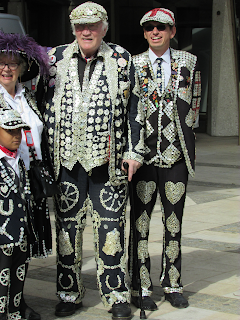The Big Valley: Eve II, 2008
There have been various exhibitions devoted to photographers and their art over the last few months in London. I saw the August Sander at Hauser and Wirth (here), but missed the Cindy Sherman at Sprüth Magers. I was really glad that I made the effort to catch this double-header of Alex Prager and Tish Murtha at The Photographers Gallery though. Like Gregory Crewdson - who's work I discovered at the same venue (here) - Prager has a very cinematic aesthetic, producing large format prints which appear to draw inspiration from the works of Alfred Hitchcock (The Birds, above), and David Lynch. It is no surprise then, that her work should go on to develop from telling stories through large-scale stills into filmmaking proper. Prager's aesthetic is also built on artifice. All of the situations depicted in her stills are contrived to manipulate a response - either sympathy for the heroine, or to question the narrative contained in the image.
Culver City, 2014
Prager heavily directs and composes her photographs in much the same way a film director does, using a cast of extras because of their physical looks or personal style, and adopting unusual noirish viewpoints when needed to enhance the sense of drama and narrative as in the image above.
Crowd #9 (Sunset Five), 2013
Crowd #7 (Bob Hope Airport), 2013
I particularly enjoyed Prager's Crowd scenes with their casts of extras. The clothes and props were all carefully chosen to evoke a certain atmosphere, and they are so packed with detail. They seem to be full of uniquely American types (stereotypes and caricatures?), and really recalled the works of both legendary American illustrator Norman Rockwell, and the hyperrealist sculptor Duane Hanson (here). The work of Cindy Sherman was also evoked with the wigs and personas that many of the women wear that people Prager's work.
Norman Rockwell - Christmas at Chicago Union Station, 1944
Duane Hanson - Tourists II, 1988
Crowd #3 (Pelican Beach), 2013
Crowd #1 (Stan Douglas), 2013
Face In The Crowd #5 Washington Square West, 2013
This image made me smile. I wanted to know exactly what the black man seen in the top left-hand window has seen/is looking at, to make him pull that face.
Shopping Plaza #2, 2015
I thought the use of negative space in the image above was quite daring, and told a story in itself with the figures marginalised and removed to the extreme edges of the composition. The way the cracks in the pavement and spaces between the paving stones direct your eye around the image, was another interesting pictorial device in the image.
Eye #2, Boulder, 2012
The tension implicit in these two images from Prager's Eye series is palpable, and the full titles of the pictures in this series ask many questions. Have the people depicted been involved in, and are therefore (dead) victims of accidents? Or are they still alive, and therefore mere observers and onlookers of the dramas in the titles?
Eye #5 Automobile Accident, 2012
There are more questions posed by the following series of images in which the drama is much more explicit. You are unwittingly drawn into the drama whether you want to be or not, and are compelled to want to know exactly what the hell happened here? This series of images are so artfully contrived and composed to curiously good, (and unintentionally humorous), effect.
3:32pm Coldwater Canyon, 2012
3:14pm Pacific Ocean, 2012
4:01pm Sun Valley, 2012
4:01pm Sun Valley has another very strong, emotive narrative. It again evoked the work of another American great - Edward Hopper - who himself was a master of storytelling through an implied narrative in his imagery.
Edward Hopper - Railroad Sunset, 1929
Act III, Scene 2, 2016
Below you can see Despair - Prager's first short film which, given her cinematic influences, was inevitably, the next logical trajectory for her work to take.
In stark opposition to the highly stylised artifice in the images of Alex Prager, on the first floor of the Photographers Gallery you can see the reportage/documentary-style of photography by Tish Murtha (1956-2013) which appears to be the antithesis of Prager's photography. By documenting the harsh realities of Thatcher's Britain of the late 1970s and early 80s Murtha hoped to effect a change for the young, and those marginalised and disadvantaged communities of the North suffering from inequality and deprivation. Murtha's pictures are on a more intimate, manageable scale than the large-scale, glossy images of Prager, recording momentary glimpses of incidents in real-life, which naturally draw the viewer in. Because the subject matter of this work is concerned with the plight of mainly working class subjects, Murtha's photography evokes a sense of empathy, or revulsion I guess, depending on your political viewpoint. The work of both women makes for a really entertaining contrast of styles, and thought-provoking visit to the Photographers Gallery.
Tish Murtha - Ex-Miner, Newport, Wales, 1976-78
Tish Murtha - Youth Unemployment, 1981
Tish Murtha - Elswick Kids, 1978
Tish Murtha - Youth Unemployment, 1980
Tish Murtha - Juvenile Jazz Bands, 1979
until 14th October
The Photographers Gallery
16-18 Ramillies Street
London
W1


















































































